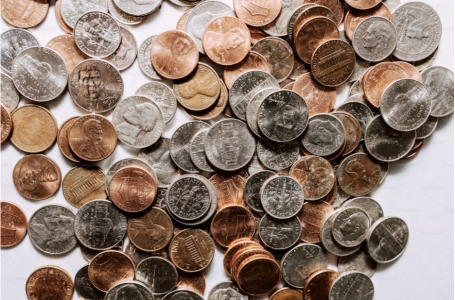Pennies are disappearing—here’s what to do with your old coins
- Replies 1
America is moving beyond cash, and the penny is officially on the chopping block. Under a directive from former President Donald Trump, the US Mint will cease penny production due to the coin's persistent cost overruns.
This marks the beginning of the end for the lowest-denomination US currency, which often costs nearly two cents to make.
But now that the penny is retiring, many Americans are asking the same thing: what should we do with all these old coins?
Most people don’t realize they’re sitting on $60 to $90 in loose change, according to the Federal Reserve. Kevin McColly, CEO of Coinstar, wants Americans to stop thinking of coins as clutter and start seeing them as currency again.
“People underestimate the value of their jar by about half,” McColly said. “It’s a wonderfully pleasurable experience. People have this sensation of found money.”
Though consumers still use billions of coins annually, their role in the economy is shrinking. Just 16% of transactions in 2023 were made in cash, the Fed found, and nearly 40% of Americans told Pew they never use cash at all.
Still, McColly sees opportunity in what others throw away, as Coinstar alone processes $3 billion in change each year. “They’re metal,” he said. “And they have a long and useful life.”

Coinstar takes a small cut for turning your change into cash, but they waive fees if you opt for a gift card instead.
McColly’s not the only one advocating for turning in idle coins: Kimberly Palmer, personal finance expert at NerdWallet, recommends using a bank or credit union to convert coins for free.
“I think that a lot of people probably do have hidden coins stashed around their home, and it can be worth their time to go and collect them,” she said. Just note that some banks may require you to roll the coins yourself.
The US Mint still produces more than 5 billion coins annually, though that number is trending downward.
Also read: This penny in your drawer could be worth more than you think!
“Those are just natural resources coming out of the Earth,” McColly said, pointing to the environmental toll of minting new copper and nickel coins.
By returning coins to circulation, consumers can help reduce the demand for new ones. And given the Treasury’s growing losses nearly three cents per penny and almost nine per nickel—that reduction matters.
President Trump’s directive only applies to pennies, but experts are already raising questions about nickels.
“The penny is outdated and inefficient and no longer serves the needs of our economy,” said Sen. Kirsten Gillibrand, a co-sponsor of the Common Cents Act, which proposes rounding transactions to the nearest five cents.
But critics warn that eliminating pennies might create a nickel surplus, increasing losses even more. Without both, the structure of cash pricing could be fundamentally disrupted.
So what about rare coins? Could that penny in your junk drawer be worth a fortune? Probably not, say experts like Donn Pearlman of the Professional Numismatists Guild. “There are million-dollar pennies, but there are no $100 million pennies,” Pearlman said.
Most “wheat pennies” from 1909 to 1958 are only worth slightly more than face value. However, a few rare varieties—especially those from 1943 mistakenly minted in bronze—can fetch up to $1 million.
“Of course, anything is possible, right? But not likely,” said John Feigenbaum of Greysheet and executive director of the PNG. Even then, the most valuable examples have already changed hands at well-publicized auctions.
Also read: Are pennies on the way out? What the end of the one-cent coin could mean for you
Think you've struck it rich with a rare coin? Experts suggest reading “The 2026 Red Book: A Guide Book of United States Coins” to assess your collection.
While mobile apps can provide quick checks, they're often unreliable or misleading. “You'll see in that book there's no million-dollar cents,” Feigenbaum said. If you’re serious, get your coins graded through a reputable service like PCGS, CAC, or NGC.
Online rumors about ultra-valuable pennies have led to a flood of misleading headlines and overhyped listings.
Feigenbaum warns that many of the “rare” coins sold on sites like eBay or Etsy are counterfeit, often produced in China.
“If I've seen these coins ... somebody is every now and again being taken advantage of,” he said. Coin shops across the country are reporting increased walk-ins from hopeful collectors—most of whom leave disappointed.
Read next: Discover the one penny date that could turn your loose change into a $240,000 windfall—learn the secret behind its rare material!

Have you checked your coin jar lately? Could you be holding onto a piece of history, or at least a few bucks in forgotten change? Let us know in the comments: Are you saving your pennies or cashing them in?
This marks the beginning of the end for the lowest-denomination US currency, which often costs nearly two cents to make.
But now that the penny is retiring, many Americans are asking the same thing: what should we do with all these old coins?
Most people don’t realize they’re sitting on $60 to $90 in loose change, according to the Federal Reserve. Kevin McColly, CEO of Coinstar, wants Americans to stop thinking of coins as clutter and start seeing them as currency again.
“People underestimate the value of their jar by about half,” McColly said. “It’s a wonderfully pleasurable experience. People have this sensation of found money.”
Though consumers still use billions of coins annually, their role in the economy is shrinking. Just 16% of transactions in 2023 were made in cash, the Fed found, and nearly 40% of Americans told Pew they never use cash at all.
Still, McColly sees opportunity in what others throw away, as Coinstar alone processes $3 billion in change each year. “They’re metal,” he said. “And they have a long and useful life.”

America is moving beyond cash, and the penny is officially on the chopping block. Image source: Sandra Seitamaa / Unsplash
Coinstar takes a small cut for turning your change into cash, but they waive fees if you opt for a gift card instead.
McColly’s not the only one advocating for turning in idle coins: Kimberly Palmer, personal finance expert at NerdWallet, recommends using a bank or credit union to convert coins for free.
“I think that a lot of people probably do have hidden coins stashed around their home, and it can be worth their time to go and collect them,” she said. Just note that some banks may require you to roll the coins yourself.
The US Mint still produces more than 5 billion coins annually, though that number is trending downward.
Also read: This penny in your drawer could be worth more than you think!
“Those are just natural resources coming out of the Earth,” McColly said, pointing to the environmental toll of minting new copper and nickel coins.
By returning coins to circulation, consumers can help reduce the demand for new ones. And given the Treasury’s growing losses nearly three cents per penny and almost nine per nickel—that reduction matters.
President Trump’s directive only applies to pennies, but experts are already raising questions about nickels.
“The penny is outdated and inefficient and no longer serves the needs of our economy,” said Sen. Kirsten Gillibrand, a co-sponsor of the Common Cents Act, which proposes rounding transactions to the nearest five cents.
But critics warn that eliminating pennies might create a nickel surplus, increasing losses even more. Without both, the structure of cash pricing could be fundamentally disrupted.
So what about rare coins? Could that penny in your junk drawer be worth a fortune? Probably not, say experts like Donn Pearlman of the Professional Numismatists Guild. “There are million-dollar pennies, but there are no $100 million pennies,” Pearlman said.
Most “wheat pennies” from 1909 to 1958 are only worth slightly more than face value. However, a few rare varieties—especially those from 1943 mistakenly minted in bronze—can fetch up to $1 million.
“Of course, anything is possible, right? But not likely,” said John Feigenbaum of Greysheet and executive director of the PNG. Even then, the most valuable examples have already changed hands at well-publicized auctions.
Also read: Are pennies on the way out? What the end of the one-cent coin could mean for you
Think you've struck it rich with a rare coin? Experts suggest reading “The 2026 Red Book: A Guide Book of United States Coins” to assess your collection.
While mobile apps can provide quick checks, they're often unreliable or misleading. “You'll see in that book there's no million-dollar cents,” Feigenbaum said. If you’re serious, get your coins graded through a reputable service like PCGS, CAC, or NGC.
Online rumors about ultra-valuable pennies have led to a flood of misleading headlines and overhyped listings.
Feigenbaum warns that many of the “rare” coins sold on sites like eBay or Etsy are counterfeit, often produced in China.
“If I've seen these coins ... somebody is every now and again being taken advantage of,” he said. Coin shops across the country are reporting increased walk-ins from hopeful collectors—most of whom leave disappointed.
Read next: Discover the one penny date that could turn your loose change into a $240,000 windfall—learn the secret behind its rare material!
Key Takeaways
- President Trump ordered an end to penny production due to cost overruns, but the Mint continues to lose money on nickels as well.
- Most households have $60–90 in coins lying around, according to Federal Reserve estimates, and converting them can be an easy cash win.
- Rare coins like the 1943 bronze Lincoln wheat penny do exist, but finding one is about as likely as winning the lottery.
- If you're unsure about your coins' value, consult “The 2026 Red Book” or a professional grading service for accurate verification.






